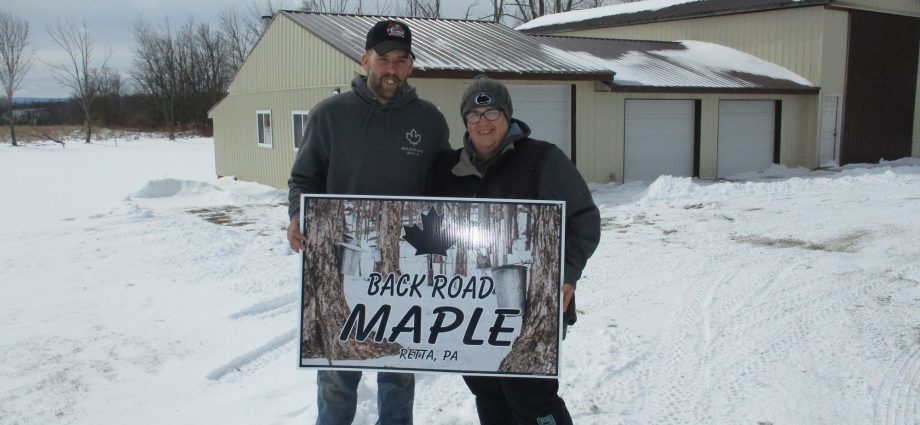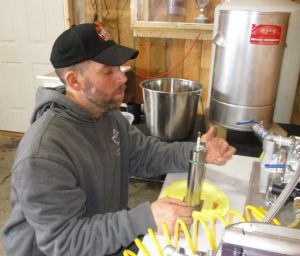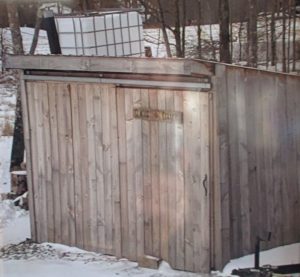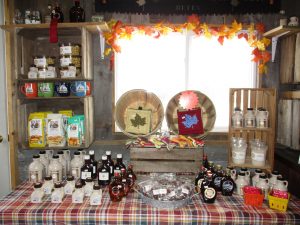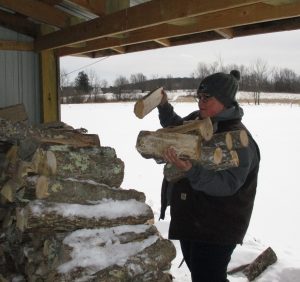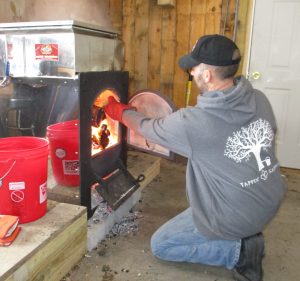Eric, Sara and Morgan (not pictured) Robinson have opened the doors of their sugar house at 2694 Carter Road in Retta to the public, turning a cherished hobby into an attractive cottage business. Above, Eric tests a batch with a hydrometer to see how close it is to being syrup.
Story and photos by Rick Hiduk
(originally published in the Susquehanna County Independent)
Eric Robinson describes making maple syrup with his wife, Sara, and daughter Morgan, a “hobby gone wild.” He’d watched others boil down sap collected from local maple trees and decided he wanted to give it a go. His first evaporation unit was an old oil tank modified to accommodate a two-by-two-foot flat tray.
“It worked but it was dangerous,” Sara wrote in a brief history of how Back Road Maple got it’s start.
“We only made a gallon or two of syrup with it,” Eric related. “It just wasn’t efficient.”
Boiler number two was a big step up, with a two-by-five flat pan that could handle 14 gallons of sap per hour. It was housed inside a small sugar shack (above) that was crowded and chilly due to a lack of insulation. But the Robinsons were getting better at making syrup, so they decided to further enhance their operations. They also resolved to go pro in 2022.
Eric constructed a larger, insulated sugar house in which he installed a two-by-six raised-flue Leader evaporator. He can now process 32 gallons of sap per hour at a two percent sugar content. The new building also has room for retail space for the Robinson’s syrup and related products from other sources.
Eric and Tara have lived at 2694 Carter Road for 18 years, during which time they have also worked full-time with Meshoppen Stone and People’s Security Bank, respectively. Morgan is 17.
“It’s been a busy 18 years,” Sara said with a laugh. Neither have any intentions of leaving their day jobs for what Sara calls a “full-time hobby.” The couple agreed that they will take on a little bit more each year until they feel that they have met their potential capacity. Morgan assists with every aspect of production, in addition to designing the product logos and labels. “She’s a big part of this small business,” Sara remarked.
They pursued maple syrup production out of curiosity and the desire to try something new and, as they continued to improve, they wanted to share it with the public. Winning a red ribbon for their syrup at last year’s Harford Fair helped them realize that the time was right. Sara maintains the Back Road Maple Facebook page on which she posts optimum times for people to stop by to see them working.
“I like meeting people and explaining the process,” Eric remarked. “I learn something new every time I do it.”
The sap is collected within a 10-mile radius of their home, from neighbor Reed Carter, friend Linsey Bender, and Eric’s parents’ property. While sugar maples produce the most sap with the highest sugar content, Eric says, “I tap every maple I can get to and get what I can out of it.” Forty-three gallons of sap at two-percent sugar content are needed to make each gallon of syrup.
Boiling and evaporation is a tedious, hands-on process. Family members take turns stoking the fire from the wood pile outside the back door. The boiling point, which averages 212 degrees, can vary with the barometric pressure. During the snow storm of March 12, for example, the sap started boiling at 211 degrees. The heat is slowly increased until the sap reaches what Sara calls the “magic number,” which is generally between 217 and 219 degrees.
As the batch gets closer to that point, Eric draws off some of the brownish liquid into a test cup, which resembles a metal beaker with a handle. He then inserts a hydrometer which is buoyed by the syrup. When the red line on the hydrometer is at the surface, the syrup is ready. Within a few minutes, just the syrup in the evaporation pan auto-drafts into a waiting stainless steel bucket.
Sap will continue to run through most of March and sometimes into April, Eric explained. “You usually get about six weeks in a good year,” he stated. Warmer days and nights that are still below freezing allow for the best tapping. “You need that cold to draw the sap down. Without it, the sap stays up in the tree, which eventually starts to bud.” That’s when the season ends.
Because of their day jobs, retail hours at the sugar house fluctuate but are generally Friday evenings from 6 to 10 and Saturday and Sunday from 9 am to 4 pm. The Robinson’s syrup is accompanied on the shelves by hard candy, maple-flavored cotton candy and pop corn, and three varieties of pancake mix (of course). Interested readers may call ahead at 570-903-0192, especially if they are interested in seeing the a boil in action.
Cub Scouts from Pack 97 in Springville recently visited them, and Bear Den leader Tyler White returned over the weekend with his son to observe a full boil. “It was a great opportunity for the Scouts to learn all about the process and dedication that goes into collecting sap and turning into maple syrup,” White said after the return trip. “It also gave my son a chance to see in person what his great grandfather used to be so passionate about every spring making maple syrup on our family farm just a few miles from the Robinsons.”
submitted photo
Sara said that the Scouts were amazed by the 500 gallons of sap waiting in the bulk tank behind the shop.
An open house event is slated for Friday to Sunday, March 18 to 20, from 9 am to 4 pm each day. The Robinsons also welcome tour groups by appointment. There is no cost for the tours, which the family seem to enjoy as much as making syrup.
“We aren’t large, but we are big enough,” Sara posted on Facebook. “We love what we do, and we love sharing our story.”
Photos by Rick Hiduk
Sara grabs some more split wood for the boiler as the couple pushes the evaporating sap towards the prefect temperature.
Eric loads wood into the stove of the new Leader sap evaporator.
